Organizing a Small Study Room
Welcome to the world of efficiency and creativity! Organizing a small Study room requires clever thought and clever design. Start with a clear vision. Think about how you want to use the space. Should it be a quiet place to study or a productive space for working from home? Define your goals so you can optimally design the space. A well-thought-out plan is the key to maximizing every square inch of your small home office.
When choosing a location, consider not only the size of the room, but also the surrounding area. A quiet place away from distractions promotes concentration. Make sure there is natural light and ventilation to create a comfortable working atmosphere. Choose furniture that flatters the room. Folding desks and wall-mounted shelves can work wonders to optimize limited space. Also take advantage of the vertical space shelves up to the ceiling not only create additional storage space, but also make the room appear larger.
Finally, for Organizing a Small Study Room choose furniture and storage that is not only functional but also aesthetically pleasing. A small home office can be stylish and inspiring. A well-organized space helps you focus on what’s really important: your work or studying.
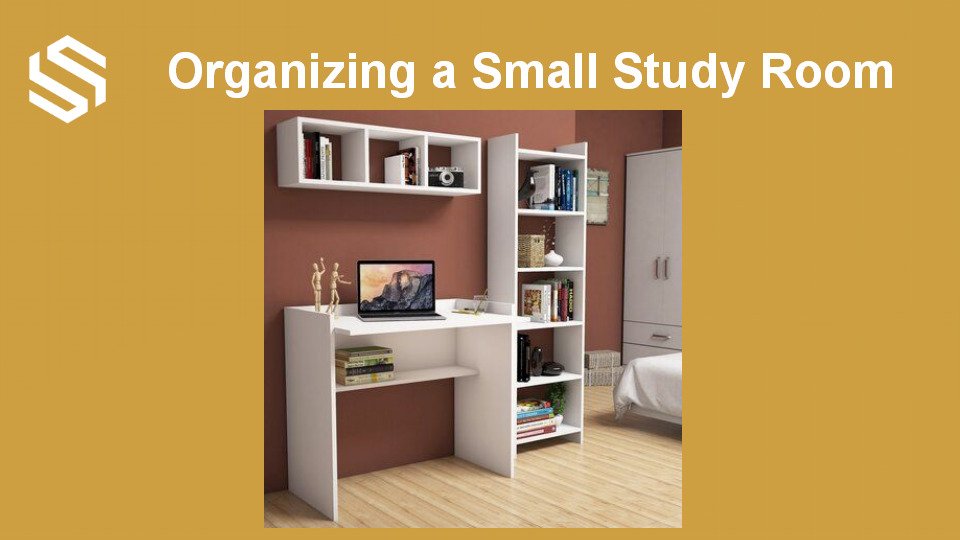
Organizing a Small Study Room & Setting Up Your Study Room
So talking about Organizing a Small Study Room A study room is more than just a place to study. It is your personal space for growth and development. Setting up your study room is not just about the furniture, but also about the atmosphere you create. Start with a floor plan and furniture arrangement that uses the space effectively. Consider how you move and work and place your furniture accordingly. Effective use of space is key in a small room.
Ergonomics should be a top priority when setting up a study room. A comfortable chair and a well-positioned desk not only promote productivity, but also health. Make sure there is adequate lighting, preferably daylight, to protect the eyes and create a positive learning environment. Personalize the space with inspiring decor that will boost your motivation. This could include an inspirational wall plaque, motivational quotes or personal mementos.
After all, your learning space is a reflection of your personality. Use the time to personalize your space. Learn effectively by being in an environment you love and value. Your learning journey begins not only with the books but also with the environment you have created.

Define Your Study Goals
Defining your study goals is the first step on your journey of learning and growing. Think carefully about what you want to achieve. Would you like to learn new skills, deepen your knowledge or perhaps obtain a specific certificate? Clearly defining your goals will not only help make your learning space more effective, but also keep you motivated. Write down your goals and place them visibly in your study. This will remind you why you created this space and what you want to achieve.
Choose an Appropriate Location
The location of your study room plays a crucial role in Organizing a Small Study Room and learning experience. Choose a place that is quiet and free of distractions. Ideally, it should be located away from daily traffic to enable undisturbed learning. Make sure the room is well ventilated and has natural light. A window with a view of nature can not only have a calming effect, but also promote concentration.
When choosing a location, also consider the practical aspects. Is the room easily accessible? Are there enough sockets for your electronic devices? A suitable location not only makes learning easier, but also creates an environment that you enjoy visiting. Your study space should be inviting and make you feel like you can concentrate on your studies without being disturbed by outside influences.
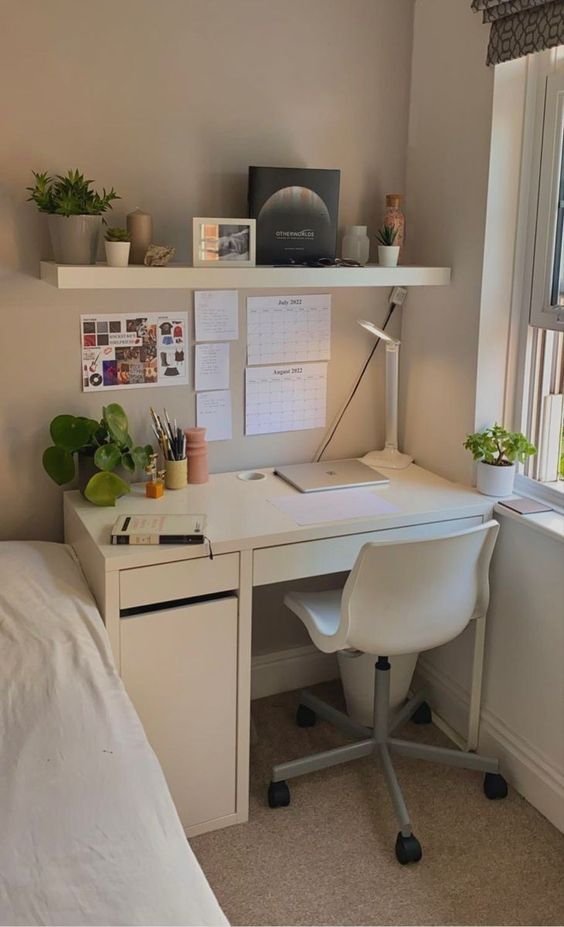
Consider Natural Light and Ventilation
Another important aspect for Organizing a Small Study Room. Natural light and fresh air are the invisible sources of energy in your learning space. Open your curtains to let in the natural light, which will not only improve your mood but also be easy on your eyes. Place your workspace near a window to benefit from natural lighting. If possible, open windows for good ventilation. Fresh air promotes oxygen delivery to the brain and keeps you alert and focused.

Pick the Right Study Furniture
Your choice of Study furniture can have a significant impact on your productivity and well-being. Start with an ergonomic desk and a comfortable chair to avoid back pain and fatigue. Make sure the furniture fits the dimensions of your study room to ensure optimal use of the space. Foldable or multifunctional furniture can be a real space saver in a small room.
Also think about storage options. Shelves, drawers and organizers help keep the room tidy. Choose furniture that is not only functional but also meets your aesthetic preferences. An attractively designed learning room can have a positive impact on the learning atmosphere and help you concentrate better on your tasks. Think of your work furniture as an investment in your efficiency and learning comfort.

Make the Most of Vertical Space
In a small home office, effective use of vertical space is crucial to making the most of your limited space. Ceiling-length wall shelves are not only aesthetically pleasing, but they also provide additional storage space without taking up valuable floor space. Also consider hanging organizers that can be attached to the wall to keep smaller items like office supplies or personal notes within easy reach. These clever solutions take advantage of the vertical dimension of your space while creating a clutter-free environment.
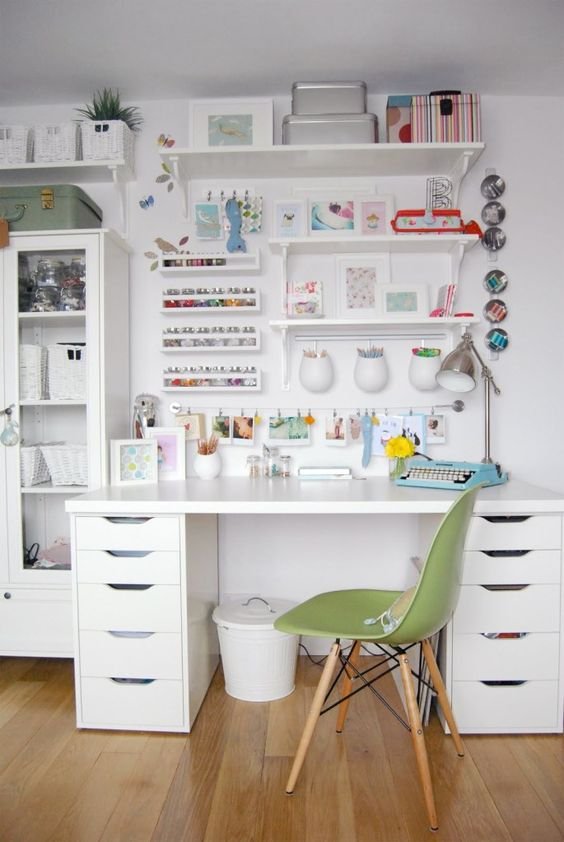
Select Appropriate Storage Solutions
Choosing appropriate storage solutions is key to organizing your small home office. Consider what types of items you need to store, then choose the appropriate furniture or containers. Open shelves are ideal for displaying books, folders and decorative items, while closed cabinets can hide clutter. If you’re short on space, consider multi-functional furniture pieces like ottomans with built-in storage or folding desks with built-in shelves.
Don’t forget the backs of doors and walls as potential storage space. Hooks, shelves, or bags hanging on doors provide additional space for smaller items. Remember, choosing the right storage solutions not only improves organization but also helps create an inspiring and productive atmosphere in your small home office. By using the storage space cleverly, you create more space to develop and concentrate on your tasks.
Arranging a Small Room for Studying
Layout and Furniture Arrangement
A well-thought-out floor plan and careful furniture arrangement are the cornerstones of a well-organized small home office. Start with a sketch or floor plan to visualize the dimensions of your space. This allows you to use space efficiently and identify the best positions for furniture pieces. Remember that the floor plan should take into account not only the furniture, but also traffic flow and natural lighting. Experiment with different layouts to find the optimal arrangement that suits your needs.
Effective Space Utilization
In a small room, effective use of space is crucial to make every inch count. Choose space-saving furniture that can serve multiple functions. Folding desks and wall-mounted shelves are great options for creating extra space when needed. Also consider furniture pieces with built-in storage space to minimize clutter. Consider the vertical dimension of the room by using tall shelves to draw the eye upward and make the room appear larger. The right furniture arrangement combined with clever use of space creates a functional and harmonious workspace.
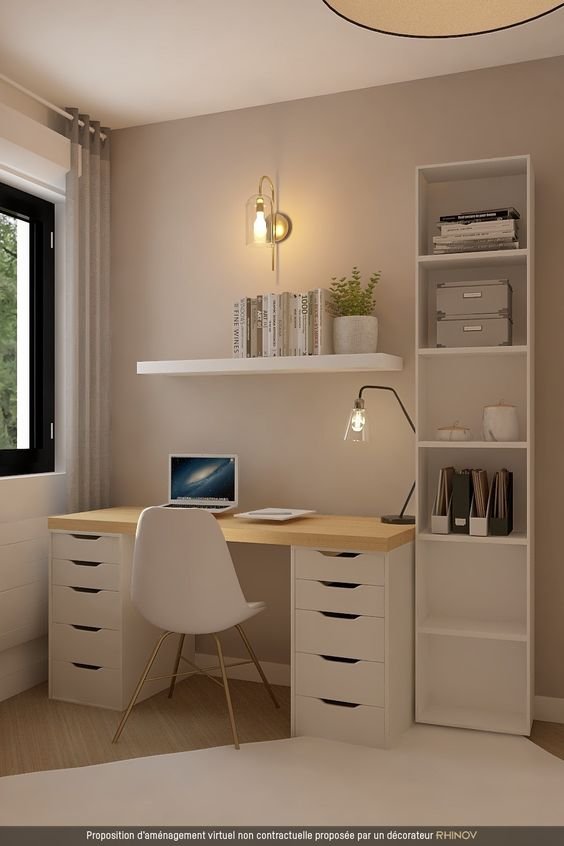
Ergonomics for a Small Study Room
Ergonomics play a crucial role, especially when you work for long hours in a small study. Start with an ergonomic desk and chair that promote correct posture and prevent back pain. Make sure your computer screen is at eye level to minimize neck strain. Since space is limited, choose space-saving furniture that can be easily adjusted to suit your needs. Invest in ergonomic solutions that not only increase productivity but also promote well-being. A well-designed ergonomic workplace helps you concentrate on your tasks without neglecting your health.
Personalizing the Space
Personalize the space
Your study should not only be functional, but also inspiring and unique. Personalizing your workspace creates an environment that motivates and gives you a sense of belonging. Start with a color palette that reflects your personality. Colors have a strong influence on mood – calming blue tones, motivating yellow or earthy tones can be chosen depending on your preference. Hang inspirational artwork, photos or quotes on the wall that motivate you and encourage your creativity.
Bring personal items into the room that bring you joy, be it a plant, souvenirs from travel, or personal notes. A comfortable rug or pillow can not only warm up the room, but also emphasize your personal style. Organize your workspace in a way that gives you a sense of order and control, while still leaving space for the personal things that are important to you. Personalizing your study not only creates a place to work, but a space in which you enjoy spending time and can develop to the fullest.

Tips for Setting Up Your Study Room
- Decluttering and Organization
At the heart of an efficient home office is a thorough decluttering and organization strategy. Start by taking inventory of your belongings. Evaluating and sorting are crucial to determining which items you really need and which can make room for something new. Sorting out can be liberating and creates space for a clearer workspace.
Then organize your items so they are easily accessible. Use storage solutions like baskets, bins and shelves to minimize clutter and keep everything in its place. Also think about which things are needed on a daily basis and which can take a back seat. A tidy room promotes concentration and creates a pleasant working environment.
Also consider minimalist approaches to improve the aesthetics of your home office. Less is often more, and a tidy space can calm the mind and increase focus. Maintaining a tidy learning space doesn’t just mean putting things in their place, but also consciously deciding which things will really enrich your space.
- Creating a Distraction-Free Environment
Creating a distraction-free environment is crucial to maximizing your concentration and working effectively. Start by identifying distractions, whether they be noise, technology, or outside influences. An effective way to do this is to establish clear boundaries. Inform family members or roommates about your working hours so that you can remain undisturbed.
In addition to the external environment, it is important to minimize digital distractions. Turn off notifications on your phone or computer when you’re focusing on important tasks. Create clear schedules for breaks to recover, but keep them limited to maintain focus.
Design your workspace to be clutter-free to minimize visual distractions. A tidy desk and clear work surfaces create a calm atmosphere that has a positive effect on your productivity. Remember that creating a distraction-free environment is not just about the physical environment, but also the conscious decision to focus on the tasks in front of you.
- Time Management and Scheduling
Well-thought-out time management is the key to an effective learning space. Start with a clear schedule in which you set your study times. Identify the periods when you are most productive and reserve them for the most demanding tasks. Create a realistic timetable that takes into account not only studying, but also breaks and recovery time.
Use tools like calendars, apps or planners to organize your tasks and keep track of deadlines. Set clear goals for each study session to maintain focus and track progress. Well-structured scheduling not only helps you keep track of your tasks, but also minimizes stress.
Also create a visual schedule in your study space. A wall calendar or board can be used to keep track of important dates, deadlines and milestones. By regularly updating and reviewing your schedule, you not only stay on track but also create awareness of the time you invest in your learning activities. Time management is not just a tool, but a way to effectively achieve your learning goals.
- Maintaining Your Study Room
Maintaining your study space is crucial to maintaining a productive and enjoyable learning environment. Start with regular cleaning to minimize dust and clutter. A clean room not only promotes concentration, but also creates a positive atmosphere. Take time regularly to tidy up the room and put things back in their place.
Pay attention to the care of your furniture and technical devices. Make sure your work furniture is in good condition and ergonomically supportive. Clean your desk, screen and keyboard regularly to maintain a hygienic environment. Check lighting and replace light bulbs as necessary to maintain a well-lit work surface.
Organize your storage solutions regularly and check that you have all the materials you need. Clear out and reduce clutter regularly to keep the space functional. Take care of your personal elements too, whether by watering plants regularly or checking photos and decorations.
Maintaining your study space is not just an external measure, but also helps create an environment that supports your motivation to learn. A well-maintained space not only reflects your care, but also creates a place where you enjoy being and can work effectively You can read more here
How do I declutter my study room?
What to Include in Your Study Room
Essential Study Furniture
In order for your study to function optimally, some essential study furniture is crucial. Start with an ergonomic desk and a comfortable chair. The desk should provide enough space for your work materials, while the chair supports your spine and is suitable for long working hours.
A well-organized workplace also requires adequate storage space. Shelves, drawers or filing cabinets help to neatly store documents, books and office supplies. Invest in multifunctional furniture that meets your needs. Folding desks or rolling containers are great options for making space flexible.
Lighting also plays an important role. A glare-free desk lamp and sufficient daylight are crucial to well-illuminating your work surface. Also consider the placement of electrical outlets to make it easier to use electronic devices.
Choosing essential work furniture that is both functional and comfortable lays the foundation for a well-equipped and efficient workspace.

Study Supplies and Stationery
The right learning materials and stationery are the key to a well-equipped study room. Start with a selection of quality writing supplies – pens, pencils, markers and notebooks. A good set of stationery not only makes it easier to capture thoughts and ideas, but also increases the joy of writing.
Organize your study materials by using folders, folders or storage boxes. Label them clearly to allow quick access to your documents. Notebooks or flashcards can be used to record important information and support the learning process.
Also think about technical learning tools, such as a reliable computer, headphones or other devices that you need for your studies. A well-functioning printer can also be useful for printing documents.
Carefully selecting and organizing learning materials and stationery not only creates an orderly work environment, but also helps you learn efficiently and work productively.
Inspirational Decor
The right inspirational decor can transform your study space into a place of creativity and motivation. Start with wall decor that reflects your personality – be it inspirational quotes, artwork, or photos that evoke positive memories. A pin board or magnetic board can also be used to collect ideas and keep important information in view.
Incorporate plants or other natural elements into your decor. Plants not only create a pleasant atmosphere, but also improve air quality and promote well-being. Think about how you can cleverly place light sources to create atmospheric lighting. Dimmable lamps or fairy lights can create a cozy atmosphere.
Choose furniture and decor pieces that fit your personal aesthetic. A comfortable rug, pillows or blankets can not only warm up the room but also add a touch of coziness. In addition to creating an aesthetically pleasing environment, inspiring decor can stimulate your creativity and help you stay motivated.
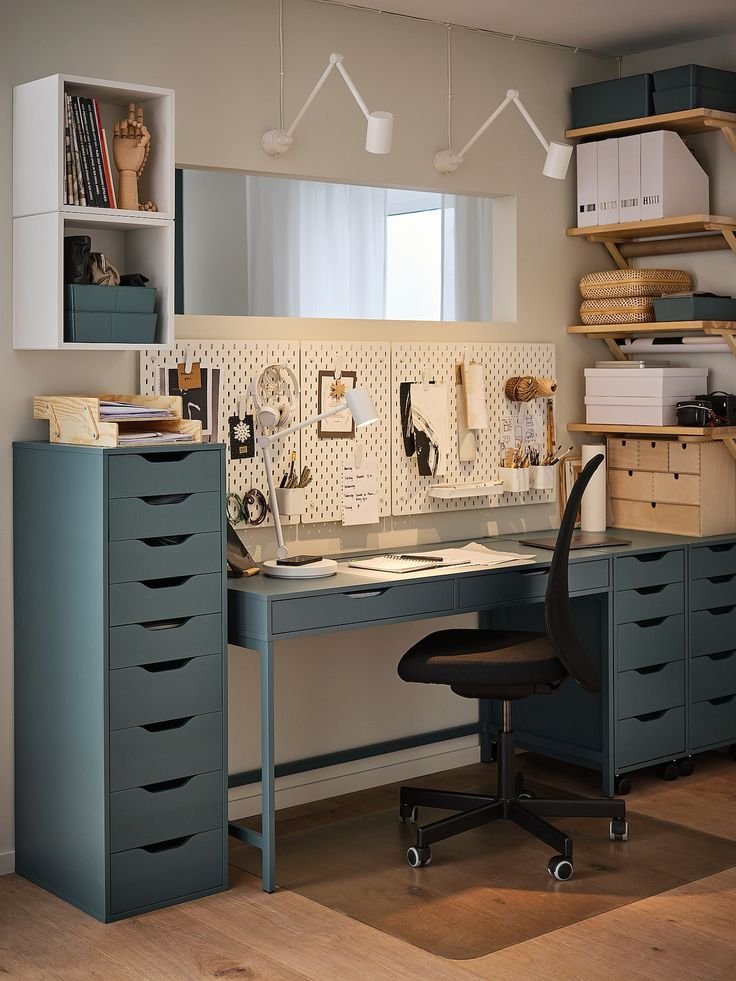
27+ Fresh New Wall Mounted Study Table Designs
Storage and Organization
Effective storage and organization are key to a tidy and functional learning space. Start by choosing furniture that offers storage space, such as shelves, drawers, and storage boxes. Invest in multifunctional furniture that not only frees up space but is also aesthetically pleasing.
Use clear containers to organize and keep track of small items. Label containers to quickly identify contents. Also take advantage of the vertical dimension of your space by installing wall shelves or wall cabinets.
Come up with a system for organizing documents, books and notes. Folders, folders or filing systems can help keep everything in its place. A tidy workplace not only promotes concentration, but also makes it easier to find materials.
Carefully storing and organizing your learning materials not only creates a well-organized space, but also helps you learn efficiently and work productively.
Decluttering Your Study Room
Assessing and Sorting Your Belongings
A critical step in designing your study space is evaluating and sorting your belongings. Go through your materials, books, and personal items systematically. Ask yourself which things are really necessary and which you no longer need. Organize your belongings by category and decide which ones to keep, donate, or throw away. This evaluation not only frees up space, but also allows you to focus on what matters.
Organizing and Reducing Clutter
Organizing and reducing clutter are crucial to an efficient learning space. After evaluating your belongings, create clear storage systems. Use shelves, bins and organizers to organize your materials neatly. Reduce visible clutter by removing things from your field of vision and keeping only necessary items. A tidy environment not only promotes productivity, but also creates a relaxed learning atmosphere.
Minimalist Approaches
In a learning space, minimalist approaches can have a transformative effect. Consider reducing decor and excess items to create a clear and uncluttered space. Less is often more – choose carefully which items are really important and which are just additional burden. Minimalism not only promotes an aesthetically pleasing environment, but also mental clarity and focus.
Maintaining a Tidy Study Space
Creating and maintaining a tidy study space is vital to your efficiency and concentration. Start by regularly going through your study space and removing unnecessary items. Evaluating and sorting your materials helps to gain clarity about what is really needed. A tidy space not only promotes a stress-free environment but also enables an effective learning process.
37+ New Fresh Study Table Design For 2024
Conclusion
Designing your ideal learning space is an individual journey shaped by conscious decisions and personal preferences. From choosing the right furniture and learning materials to incorporating personal touches and creating a clutter-free environment, every aspect contributes to making your learning space an inspiring place.
Remember that your study space is more than just a physical place. It represents your commitment to learning, your personality and your goals. Make it a place that motivates, inspires and supports you. By adapting the elements of this guide and incorporating them into your own space, you will create an environment that best suits your needs.
With a well-designed and personal learning space, you can not only work more efficiently, but also create a positive learning atmosphere that supports your success. Make your learning space a place of growth, creativity and personal development.

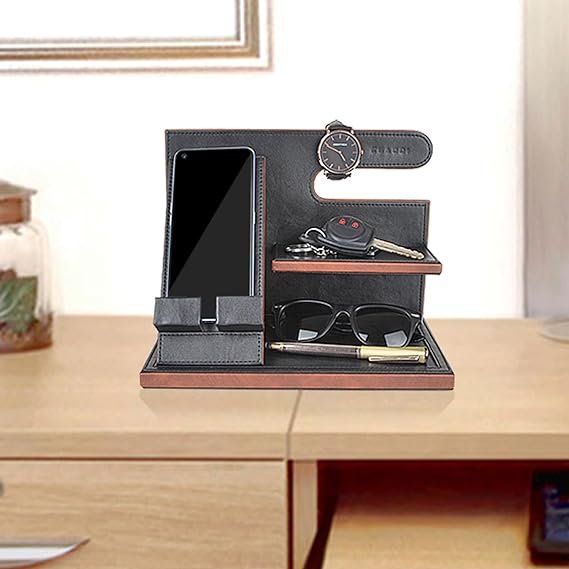

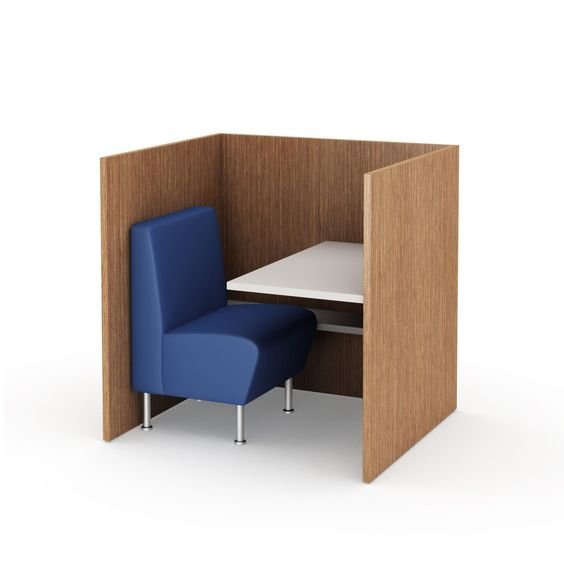
Your article helped me a lot, is there any more related content? Thanks!